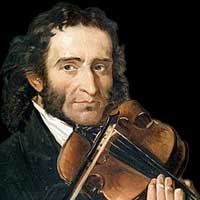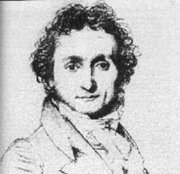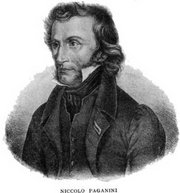Niccolo Paganini - Biography
Niccolo Paganini Biography
Niccol˛ Paganini, (Genoa, October 27, 1782 - Nice, May 27, 1840) was a violinist and composer. He was one of the most famous virtuosi of his day, and is considered to be one of the greatest violinists ever, with absolute pitch and perfect intonation, expressive bowing techniques and new uses of staccato and pizzicato techniques.
Paganini was born in Genoa, Italy. He was taught to play the violin from a very young age and was immediately recognized as a virtuoso after he gave his first public concert at the age of 11. In his early teens he studied under Alessandro Rollo and Ghiretti, but he could not cope well with his success: at the age of 19 he was gambling and drinking. His career was saved by an unknown lady, who took him to her estate, where he recovered and studied the violin for three years. He also played the guitar in his temporary retirement, and his intimate violin/guitar sonatas and guitar string quartets offer a side of Paganini that is easily overlooked.
He reappeared when he was 23, director of music to Napoleon's sister Elisa Baciocchi, Princess of Lucca, when he wasn't touring, and he soon became a legend for his unparalleled mastery of the violin, with a debut in Milan in 1813, Vienna 1828, and both London and Paris in 1831. Paganini was one of the first superstars of public concertizing. As he became more and more famous, it was rumored that he acquired his incredible virtuosity in a pact with the devil. The instrument on which he played is known as the Cannone Guarnerius violin.
Cancer of the larynx was beginning to take its toll, and he died in Nice on the 27th May, 1840, leaving behind a series of sonatas, caprices and 6 violin concertos.
In Paris in 1833, he commissioned a viola concerto from Hector Berlioz, who produced Harold in Italy for him, but Paganini never played it.
The orchestral parts of Paganini's works are polite, unadventurous in scoring, and supportive. Critics of Paganini find his concerti long-winded and formulaic: one fast rondo finale could often be switched for another. During his public career, the violin parts of the concertos were kept secret. Paganini would rehearse his orchestra without ever playing the full violin solos. At his death, only two had been published. Paganini's heirs have cannily released his concertos one at a time, each given their second debut, over many years, at well-spaced intervals. There are now six Paganini violin concerti: the last two are missing their orchestral parts
Paganini developed the set of concert variations for solo violin, characteristically taking a simple, apparently na´ve theme, and alternating lyrical variations with a ruminative, improvisatory character that depended for effect on the warmth of his phrasing, with bravura extravagances that left his audiences gasping.
One of the best known of Paganini's compositions are the 24 Caprices, written around 1817 for solo violin. They are among the most technically difficult music ever written for the instrument, calling for a very wide range of bowing techniques, extremely wide left hand stretches, double stopped trills and harmonics and left hand pizzicati. The last of these pieces, in A minor, is a set of twelve variations, and many other composers have taken its theme as the basis for a set of variations of their own. Works based on this caprice include:
- Franz Liszt - the last of his six Grandes ╔tudes de Paganini for solo piano (1851)
- Johannes Brahms - Paganini Variations (1862-63), two books of pieces for solo piano
- Sergei Rachmaninoff - Rhapsody on a Theme of Paganini (1934), a set of twenty four variations for piano and orchestra
- Witold Lutoslawski - Paganini Variations (1941), originally for two pianos, with a later version for piano and orchestra
- George Rochberg - Caprice Variations (1970), fifty new variations for solo violin
- Andrew Lloyd Webber, Variations for cello and orchestra, originally written for cello and rock band
In 1989 german actor Klaus Kinski portrayed Paganini in the film Kinski Paganini
See also
This biography is published under the GNU Licence


